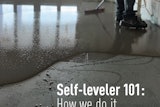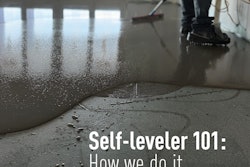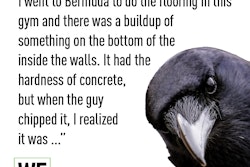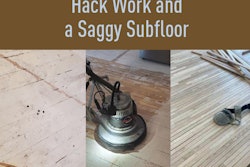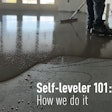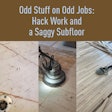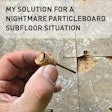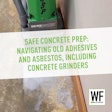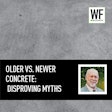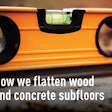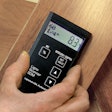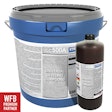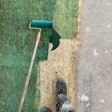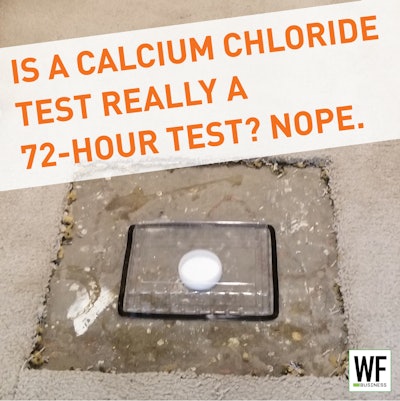
Years ago a contractor asked me for an installation quote of engineered flooring over concrete. We met at the home and, after measuring, he asked me about my lead time. I told him I had an opening in two weeks, and I was then asked how long the job would take. I stated that including the calcium chloride test, five days plue three days equals eight days, so eight days. He was puzzled and said to forget the CaCl test and just install it. I said no, because my contractor license would be in jeopardy for not following standards and the installation requirements of a glue-down floor over a concrete slab. He was frustrated with me and tried to pick apart my eight days scenario by noting that a CaCl test is only 72 hours, or three days, NOT five days. He stated that I evidently did not know what I was talking about. What he didn’t know was that this is an important part of my career, and that I had downloaded and memorized the ASTM 1869 Standard to perform a valid CaCl test. The contractor became very frustrated with me, and I left, never giving him his quote. He was thinking I was the guy who didn’t know his trade very well or something, but the important takeaway is how many people errantly believe that the 72-hour CaCl test is three days long.
Wrong! It’s a five-day test, let me show you my math.
This is how it people assume it goes. Let’s count the hours:
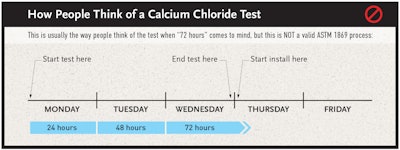
But … this common sense process does not account for the details of the ASTM 1869 criteria. The first part of the process is to open a 20-by-20-inch square to expose the slab to the environment. This can mean removing one or many vinyl floors, removing ceramic tile, cutting holes in the rug, etc.; and then a light sanding of the slab to open the pores and let it breathe. At first, there’s an emission of pent-up moisture (I call it a “blush”), but it equalizes in 24 hours—the very reason for this first step. Without this first step, the test is invalid because the extra moisture emission during the initial blush of escaping vapor will affect the final test results, for which you weigh the petri dishes. The ASTM report does not say these elements in just the way I just stated, but after long conversations with many NWFA, IFCIC and WFCA inspectors, this is the reasoning behind it.
The observation here is that not many test takers perform this first step—and it’s crucial to a valid report.
Another important observation is that no one—not a single test taker—starts the test at exactly midnight. If that were true, then sure, start on Day 1 and finish on Day 3, but that’s not how it really goes.
The way I structure the timing is to start the test prep at end of day on Monday, usually after I’ve already done my day’s work on other jobs. Then I return 24 hours later to place the test and start the 72-hour duration.
Lastly, the ASTM 1869 test protocol states the test duration lasts between 60 and 72 hours long. So, if you started at 3 p.m. on Day 2 of the test, you are not required to wait till 3 p.m. of the last day. I stop the test on Day 5 at some point after 3 a.m. (60 hours) and before 3 p.m. (72 hours). I choose 8 a.m., usually for my own personal convenience, but you can choose whatever time interval you like as long as you stay between 60 and 72 hours.
In summary, because the initial step of the test is the prep, and it requires 24 hours, that adds to the total duration of the test. Also, not many fearless test takers will begin the test at midnight, so ... It’s a five-day test allowance to put on your calendar:
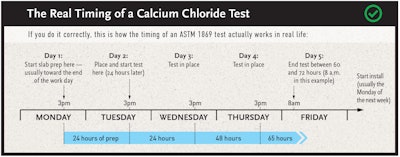
And, after all this, here’s an example of the final CaCl form I create for every job over a slab—the kind of documentation that (as I’ve discussed before) protects me in case something ends up going wrong with the floor:
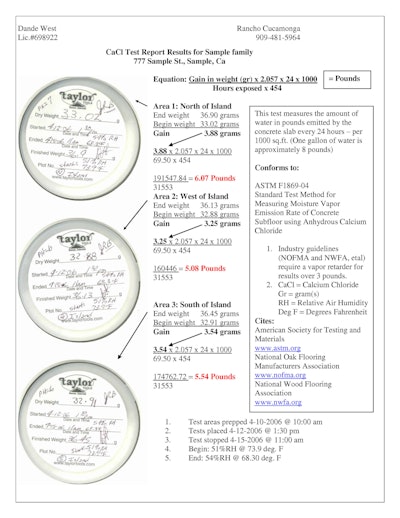
See all of Angelo DeSanto's popular blog posts and magazine articles here.










